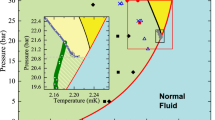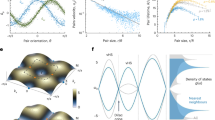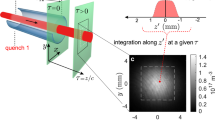Abstract
ALTHOUGH the birth of the Universe is inaccessible to experimental study, aspects of cosmological theories can nonetheless be explored in the laboratory. Tiny inhomogeneities in the mix of particles and radiation produced in the Big Bang grew into the clusters of galaxies that we see today, but how those inhomogeneities arose and grew is still unclear. Cosmologies based on grand unified theories suggest that a symmetry-breaking phase transition occurred via the Higgs mechanism about 10−34 after the Big Bang as the Universe cooled through a critical temperature of 1027 K. It has been proposed by Kibble1 that this transition may have generated defects in the geometry of space-time (such as cosmic strings), which provided the inhomogeneities on which galaxies subsequently condensed. Zurek2–4 has suggested that it might be possible to model this cosmological phase transition by a laboratory analogue, the superfluid transition of liquid 4He induced by fast adiabatic expansion through the critical density. Here we report the results of such an experiment. We observe copious production of quantized vortices5, the superfluid analogue of cosmic strings. These results support Kibble's contention that such defects were available in the early Universe to seed galaxy formation.
This is a preview of subscription content, access via your institution
Access options
Subscribe to this journal
Receive 51 print issues and online access
$199.00 per year
only $3.90 per issue
Buy this article
- Purchase on Springer Link
- Instant access to full article PDF
Prices may be subject to local taxes which are calculated during checkout
Similar content being viewed by others
References
Kibble, T. W. B. J. Phys. A9, 1387–1398 (1976).
Zurek, W. H., Nature 317, 505–508 (1985).
Zurek, W. H. Acta phys. pol. B24, 1301–1311 (1993).
Kibble, T. W. B. Nature 317, 472 (1985).
Donnelly, R. J. Quantized Vortices in Helium II (Cambridge Univ. Press, 1991).
Tilley, D. R. & Tilley, J. Superfluidity and Superconductivity 2nd edn (Hilger, Bristol, 1986).
Ginzburg, V. L. & Pitaevskii, L. P. Soviet Phys. JETP 7, 858–861 (1958).
Vilenkin, A. Phys. Rep. 121, 263–315 (1985).
Chuang, I., Turok, N. & Yurke, B. Phys. Rev Lett. 66, 2472–2475 (1991).
Bowick, M. J., Chander, L., Schiff, E. A. & Srivastava, A. M. Science 263, 943–945 (1994).
Hendry, P. C. & McClintock, P. V. E. Cryogenics 27, 131–138 (1987).
Wilks, J. The Properties of Liquid and Solid Helium (Clarendon Press, Oxford, 1967).
Williams, G. A. J. Low Temp. Phys. 89, 91–100 (1992).
Vinen, W. F. Proc. R. Soc. A242 493–515 (1957).
Schwarz, K. W. & Rozen, J. R. Phys. Rev. Lett. 66, 1898–1901 (1991).
Smith, M. R., Donnelly, R. J., Goldenfeld, N. & Vinen, W. F. Phys. Rev. Lett. 71, 2583–2586 (1993).
Author information
Authors and Affiliations
Rights and permissions
About this article
Cite this article
Hendry, P., Lawson, N., Lee, R. et al. Generation of defects in superfluid 4He as an analogue of the formation of cosmic strings. Nature 368, 315–317 (1994). https://doi.org/10.1038/368315a0
Received:
Accepted:
Issue Date:
DOI: https://doi.org/10.1038/368315a0
This article is cited by
-
Kibble–Zurek mechanism of Ising domains
Nature Physics (2023)
-
The noncommutative quantum Hall effect with anomalous magnetic moment in three different relativistic scenarios
General Relativity and Gravitation (2023)
-
Quantum thermometry in electromagnetic field of cosmic string spacetime
Quantum Information Processing (2022)
-
Kink-antikink scattering in a quantum vacuum
Journal of High Energy Physics (2022)
-
Quantum nucleation of topological solitons
Journal of High Energy Physics (2022)
Comments
By submitting a comment you agree to abide by our Terms and Community Guidelines. If you find something abusive or that does not comply with our terms or guidelines please flag it as inappropriate.



